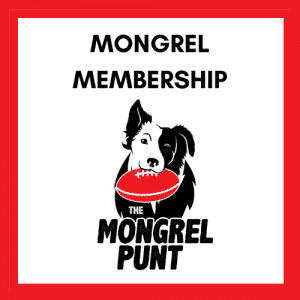Returning to the history books and analysing players’ skills from before the great game reached the heights of professionalism is a tough ask. How good would some of these players be against the modern player, like a Gary Ablett (Sr or Jr) or Dusty Martin? Surely, the modern player would win out for a myriad of factors, but we’ll never know how close it could be if the legends from those times had access to the level of information regarding professional sports, health, and fitness.
However, some players must be considered in the conversation for the Greatest of All Time because they were so far ahead of everyone else that they were playing alongside. This shows that even though all players were handicapped by the lack of understanding, these players still managed to forge ahead and stand out from the crowd of their time.
Fred Fanning fits this description to a tee, and his record of 18 goals in a single game hasn’t been surpassed even by modern-day greats like Gary Ablett Sr, Tony Lockett, and Jason Dunstall. All of whom got close, but never managed to pass Fanning’s record, at least not at an AFL or VFL level.
Fanning’s 18-goal game also wasn’t a one-off event, as the Melbourne forward recorded large bags of goals on multiple occasions. A week before Fanning kicked his record-setting 18-goal haul against St. Kilda, Fanning scored ten goals against Fitzroy. He also kicked 10 goals against the Saints earlier in the season.
Somewhat remarkably, Fanning decided that he had had enough of the VFL after his 18-goal haul. At the age of 25 years old, Fanning called time on his career in the league but continued to play football, taking on a position with Hamilton, a regional team in the south-west of Victoria, as the captain-coach. It may sound strange, but back in those times, this was a viable, and financially rewarding option for players.
Understandably, Fanning dominated the regional league and reportedly recorded multiple games where he scored above 20 goals in a single game. In one of his final seasons, Fanning notched 151 goals.
In his seven seasons of VFL football, Fanning led goal kicking in the league for half of those years. This is even more impressive given that Fanning started his career under the leadership of Melbourne’s legendary full forward, and fellow GOAT candidate, Norm Smith. Fanning would win the goal-kicking award almost every season in the second half of his career, winning the award in 1943-1945, and again in his final season of 1947.
Going back to the start of Fanning’s career, the young star was drafted by the Demons at the age of 16 years old and spent the first two years in the reserves, where he kicked over 100 goals in his first two years, including a 12-goal haul in the reserves Grand Final in 1939.
This eventually earned Fanning a call-up to the senior squad, but he started his career as a foil for Norm Smith. However, within a year and a half of his debut, the order of the Melbourne forward line switched, and Fanning became the focal point of the team’s attack, with Smith relegated to a lesser role. In 1943, when Fanning led the league in goal kicking, with 62 goals in 15 games, Smith kicked 11 goals across 12 games. This would continue in 1944 when Fanning kicked 87 goals in 14 games.
Fanning ended his career with 411 goals from 104 games, only slightly more games than John Coleman, a forward whose career was considered by many to have been tragically cut short. Fanning’s 411 goals from 104 games give him a goals-per-game average of 3.95, which is marginally behind Ablett’s goal-per-game record, and unlike Ablett, Fanning arguably retired at the peak of his powers.
Fanning would have had greater team accolades if not for his poor timing. In just his fifth game of football at Melbourne, Fanning would win a premiership, as the Demons defeated Richmond in the 1940 Grand Final. Fanning then missed the entirety of the 1941 season, including the Grand Final, where Melbourne defeated Essendon to win their fifth premiership. The season after Fanning moved to Hamilton, the Demons won their sixth premiership, defeating Essendon and ending their seven-year premiership drought.
Performances of Note
Melbourne versus Footscray, Round 12, 1943
In just his second full season, Fanning began to show the promise he had previously shown for the Melbourne reserves team. In only his 31st game for the club, Fanning kicked 11 goals in a game against Footscray. This was the first of Fanning’s numerous 10+ goal performances for Melbourne and showed signs of things to come. Fanning’s goal haul equalled the Dog’s score for the entire game.
Melbourne versus Hawthorn, Round 14, 1944
One year after his heroics against Footscray, almost to the round, Fanning had another game where he dined out, kicking 11 goals against the Hawks. Fanning’s haul surpassed the entire total for the game for the Hawks, who only scored seven goals for the entire game, and he was responsible for 50% of Melbourne’s goals as the Demons went on to win the game by 105 points.
Melbourne versus St. Kilda, Round 19, 1947
Fred Fanning saved his best game for last at Melbourne. Fanning’s record of 18 goals in a single game has remained to this very day and is unlikely to be beaten anytime soon. Despite Fanning kicking 28 goals in his final two games, it didn’t stop the legendary forward from calling time on his career in the VFL and moving to play football in regional Victoria. Before Fanning’s 18-goal haul, the record in a single game was held by Collingwood legend Gordon Coventry, who kicked 17 goals in a single game, a feat which was replicated by Jason Dunstall, who kicked 17 goals and 5 behinds in 1992 against Richmond.


